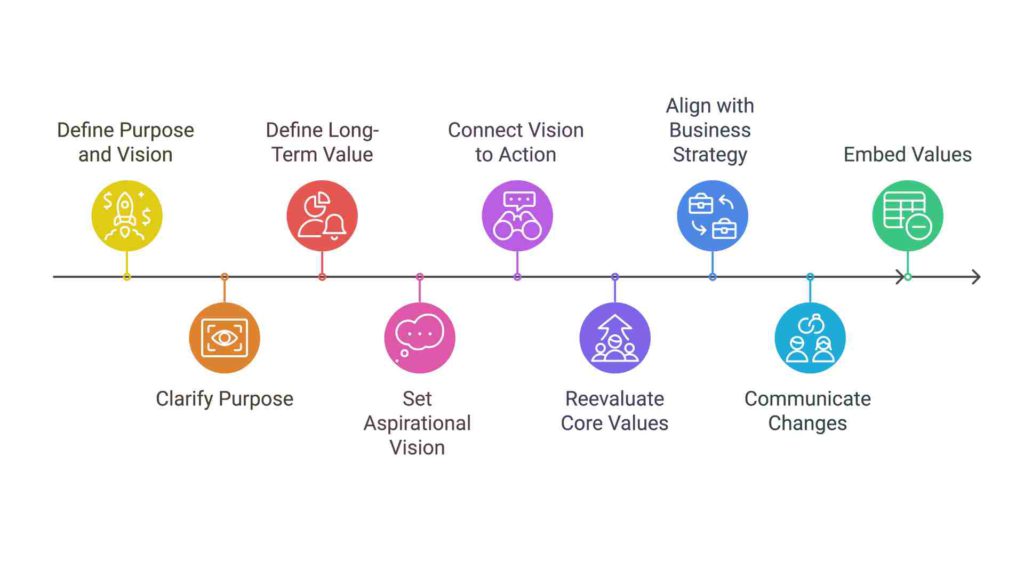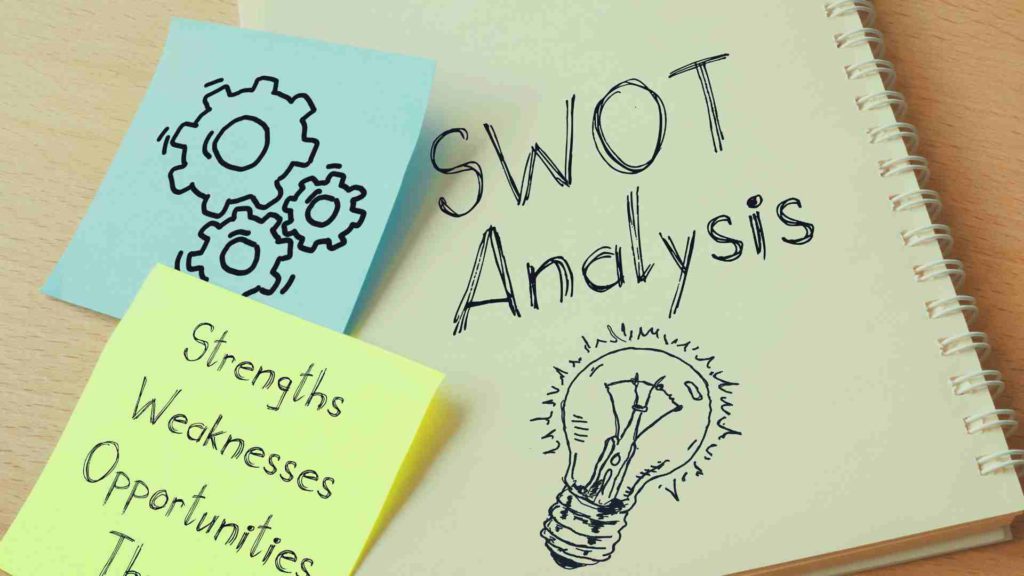Posted in Blog, Innovation, Innovation Culture, Strategy, Sustainability by Jo North
How to Update Your Mission, Vision and Values for 2026 and Beyond
Is your mission, vision, and values ready for 2025? If not, now’s the time to act. Businesses that regularly revisit these foundational elements stay relevant and competitive. Those that don’t risk misaligned teams, confused branding, and missed opportunities.
In 2025, technological advancements, shifting consumer behaviors, and societal changes like AI, remote work, sustainability, and diversity are reshaping the business landscape. Updating your mission, vision, and values ensures your business aligns with evolving market trends, employee expectations, and customer needs.
Don’t let outdated statements hold you back. Companies that embrace change thrive. Those that don’t struggle to keep up and become less relevant. Use this opportunity to refresh your purpose and position your business for growth and success.

1. Analyze Your Current Mission, Vision and Values
Before making updates, take a close look at your current position. This step helps identify what’s working and where changes are needed.
Do a Situational Analysis
Start with a SWOT analysis—a simple yet powerful tool to assess your business. It evaluates four key areas:
- Strengths: What does your business excel at?
- Weaknesses: Where are the internal gaps?
- Opportunities: What external factors could benefit your business?
- Threats: What external risks or challenges do you face?
To conduct a SWOT analysis:
- Gather input from key stakeholders across your organization.
- Use data such as customer feedback, employee surveys, and market performance reports.
- Map out each category to spot areas where your mission, vision, or values may no longer align with your goals.
Look for trends shaping 2026 and beyond, like digital transformation, AI, or sustainability. Do your statements reflect these shifts?
Engage your team, customers, and partners for their insights. Are your mission, vision, and values still relevant and meaningful to them? Use surveys, focus groups, or informal discussions to gather perspectives on what feels inspiring—or outdated.

Check The Expiry Date
Ask yourself:
- Do these statements reflect who you are today and where you want to go?
- Are they motivating for your team and customers?
- Do they address current market expectations and challenges?
If your statements feel stale or disconnected, it’s time for a refresh. A strong foundation ensures your updates will have the impact you need for 2026 and beyond.
2. Facilitate Collaborative Workshops
Workshops are an excellent way to involve your team in redefining your mission, vision, and values. They encourage collaboration, creativity, and alignment across the organization.
Lead Interactive Sessions
Bring together diverse, cross-functional teams to co-create updated statements. Collaborative sessions not only generate fresh ideas but also build a sense of ownership and commitment.
For detailed ideas on how to facilitate these workshops, check out this guide on mission, vision, and values facilitation. It’s packed with practical activities, tools, and tips to help you run an engaging and productive session.
Use Professional Facilitation Tools
Structured methodologies and toolkits can make a big difference. Leveraging proven frameworks ensures the process is effective and keeps discussions focused. Whether you’re brainstorming, prioritizing, or refining ideas, facilitation tools help create actionable outcomes.
Involve Cross-Functional Teams
Workshops are most effective when they include perspectives from different departments. Interactive resources and in-person collaboration help creativity and align everyone around shared goals. This alignment ensures your updated mission, vision, and values will resonate across the entire organization. Encourage interaction between different teams, such as the product team, operations, and HR, to create a unified understanding of the company’s activities and long-term goals. Collaborative efforts reinforce alignment and help everyone work toward the final destination.
By using the right tools and involving your team, you can craft statements that truly reflect your company’s culture and aspirations. For step-by-step advice and facilitation ideas, visit the Big Bang Partnership’s workshop guide.

3. Define Your Purpose and Vision
Once you’ve analyzed your current position, it’s time to define a clear purpose and vision. These guide everything your business does and inspire your team and stakeholders.
Clarify Your Purpose
Your purpose is your reason for existing beyond making a profit. It is your North Star. Ask yourself: Why does your organization exist? What role does it play in addressing today’s challenges?
Consider Simon Sinek’s “Start with Why“ framework. Start with your core “why” and ensure it aligns with current societal needs, like sustainability and inclusion. For example, your purpose could emphasize supporting communities, focusing on innovation, or tackling global challenges such as climate change.
Define Long-Term Value
Purpose is about your company’s impact on society, as well as about the business. How does your organization add value to customers, employees, and the world?
- Align your purpose with customer needs and aspirations.
- Support employee goals by linking their work to meaningful outcomes.
- Contribute to solving broader issues like environmental sustainability or diversity.
When you articulate a clear, value-driven purpose, it becomes a powerful tool for engaging both your team and your market.
Set an Aspirational Vision
A company vision statement should provide a clear view of your future state and final destination. A strong vision statement avoids being a laundry list of aspirations, instead focusing on one ambitious goal that resonates across the company. It should be future-focused, ambitious, and inspiring—yet achievable. Ask the following questions:
- How does the company’s vision support the company’s mission statement?
- Does it align with the needs of the target audience and target customer?
- How does it reflect the company’s core values and guiding principles?
Be inspired by great examples. For example, Hilton Hotels’ “To fill the earth with the light and warmth of hospitality,” is clear and connects to the company’s core principles and business objectives.
A great vision statement balances big-picture ambition with realism. Avoid jargon and focus on clarity and emotional impact. For instance, structure it as: [Verb] + [What] + [Impact]. Example: “Empower businesses to innovate sustainably for a better world.”
To make sure your vision works across the organization:
- Align it with your products, services, and company culture.
- Break it into actionable steps for each department, so every team sees how they contribute.
Strong vision statements from industry leaders can provide inspiration, but ensure yours reflects your unique goals.
Connect Vision to Action
Finally, tie your vision to measurable objectives. Clear steps and metrics ensure progress and keep your team motivated. The clearer and more connected your vision is, the stronger its impact will be on driving your business forward.
4. Reevaluate Your Core Values
Your core values are the foundation of your company’s culture and decision-making. Updating them ensures they remain relevant and drive the right behaviors across your organization.
Values statements should reflect the company’s reason for existing and support its overarching goal. Avoid generic phrases like “integrity” without actionable context. Instead, design values that guide decision-making and highlight specific outcomes. For example:
- A multinational corporation with a focus on social responsibility might emphasize sustainability as a core principle and tie it to resource allocation.
- A new company aiming for future growth might highlight innovation and adaptability in its values statements.
Embed these values into company activities, from the product team developing high-quality products to the business unit working on operational efficiency.
Identify Your Guiding Principles
Start by asking: What values truly reflect your company’s culture and aspirations? Choose principles that resonate with your team and inspire the behaviors needed to achieve your goals.
Keep Values Concise and Actionable
Focus on a concise set of three to five values. Each should be clearly defined in actionable terms. For example:
- Innovation: “We challenge the status quo to find creative solutions that deliver measurable results.”
- Sustainability: “We prioritize decisions that benefit the environment and future generations.”
Concise, clear values are easier for stakeholders to remember and apply.
5. Test for Relevance and Resonance
Are your new, proposed values still meaningful to your team and stakeholders? Gather feedback to ensure they resonate and reflect the company’s current direction.
For example, a startup may start with agility and innovation but later adopt sustainability and inclusion as they grow. Revisit your values periodically to ensure they continue to inspire and align with your mission and vision.
By reevaluating and embedding your core values into every aspect of your business, you’ll create a culture that supports growth and success.

6. Align Your Business Strategy with Your Updated Mission, Vision, and Values
Updating your mission, vision, and values is a powerful step, but the real impact comes when they’re fully integrated into your business strategy. Here’s how to ensure alignment across your organization:
Integrate Updates into Strategic Planning
Review your strategic goals to ensure they reflect your updated mission, vision, and values. For example:
- If sustainability is a core value, prioritize initiatives that reduce environmental impact.
- If innovation is central to your mission, allocate resources to research and development.
Every decision, project, and objective should tie back to these guiding principles, creating a consistent direction for your business. If necessary, you’ll also need to host a business strategy workshop.
AI offers powerful tools to streamline the strategic planning process. Use AI for tasks like analyzing the current state, forecasting future trends, and generating innovative ideas. For example:
- AI can identify economic opportunities by analyzing market data in real time.
- Machine learning models can predict the impact of resource allocation on future growth.
Integrating AI with your team’s insights will help to create the most robust platform for adapting your business strategy to meet your organization’s mission.
Align with Departmental Objectives
To bring your MVV statements to life, create action plans tailored to each business unit and different teams. A custom plan will ensure that every department understands how their activities contribute to the long-term vision.
- Product managers can define a good product vision that aligns with the company mission statement and addresses the value proposition for the target customer.
- Marketing teams can focus on crafting messages that showcase how the company contributes to a better everyday life while delivering the best prices or special services.
Use proven success frameworks to track progress and adjust based on measurable outcomes. The OKR Framework is a good one to start with.
Break your updated mission, vision, and values into actionable objectives for each department. For example:
- Marketing: Ensure branding and messaging reflect your new vision.
- HR: Embed values into recruitment, onboarding, and performance evaluations.
- Operations: Develop processes that support the updated mission and drive efficiency.
This ensures every team is working towards shared goals, reinforcing alignment at every level.
Incorporate Metrics and Accountability
Set clear KPIs to measure how well your strategy aligns with your updates. For instance:
- Track customer satisfaction to assess how your mission translates into action.
- Monitor employee engagement to ensure your values resonate internally.
- Evaluate market performance to see how your vision is driving long-term growth.
Review progress regularly and adjust your strategy to stay on track.
Create a Culture of Alignment
Create a culture where your mission, vision, and values are central to decision-making. Encourage leaders to model these principles and make alignment a priority in their teams. Reinforce this culture through regular communication, training, and recognition of actions that reflect your updates.
When your business strategy is fully aligned with your updated mission, vision, and values, you create a unified approach that drives success and ensures long-term impact.
7. Communicate and Implement Changes
Updating your mission, vision, and values is only the first step. To make them meaningful, you need a clear communication plan and strategies to integrate them into your organization’s daily operations.
Develop messaging that resonates with internal teams and external customers. Make sure the company vision statement communicates a strong value proposition to the target audience and reflects the company’s commitment to its social responsibility goals.
Here’s how to communicate effectively:
Develop a Clear Communication Plan
Your stakeholders need to understand not just what’s changing, but why. Start with these key steps:

- Frame the Change as a Positive Opportunity: Explain how the updates address current market trends, employee aspirations, or customer expectations. Use real-world examples to show the practical benefits.
- Share Stories, Not Just Statements: Bring the updates to life with stories or case studies that highlight how the new mission, vision, or values align with your business goals. For instance, illustrate how a value like “sustainability” is shaping product development or customer initiatives.
- Create Role-Specific Messaging: Tailor the rationale for different groups. Employees might want to know how the changes affect their work, while customers may be more interested in how they’ll benefit from improved services or products.
- Use Informal Channels: Beyond formal meetings or emails, leverage informal platforms like team huddles, social media, and casual conversations. This can make the message feel more personal and relatable.

Integrate Updates Into Organizational Practices
To truly embed your revised mission, vision, and values into your company, they need to guide daily decisions and behaviors. Start by aligning them with key processes like recruitment, performance management, one-to-ones, and customer service.
For more practical ideas on how to bring your values to life, read this article on embedding company values into everyday practice. It provides actionable strategies to ensure your values resonate throughout your organization.
Tips for Communicating Change Effectively
- Involve Ambassadors: Identify team members who strongly embody your values and ask them to champion the changes. They can help spread the message authentically across departments.
- Use Visual Reminders: Place visual cues—like posters, digital dashboards, or branded swag—in strategic locations to keep the new statements top of mind.
- Celebrate Small Wins: Highlight and reward actions that reflect the updated values. Public recognition reinforces the importance of the change.
Make It Actionable
Align your updated mission, vision, and values with measurable objectives that drive customer satisfaction and employee engagement. For example:
- Break down the new mission into team-level goals.
- Measure progress through feedback surveys or performance metrics.
- Clear communication and integration ensure your updates are more than just words—they become a vital part of your company’s culture and strategy.
8. Embed Values Into Daily Operations
Your values should guide every aspect of your business, from hiring to customer service. To achieve this:
- Incorporate them into performance reviews , one-to-ones, and team evaluations.
- Use them as a compass for decision-making at every level.
- Celebrate examples of employees embodying these values.
Global leaders such as Patagonia demonstrate this by embedding sustainability into their operations, from product design to employee initiatives. When values drive day-to-day actions, they become part of the company’s DNA:
Example: Patagonia – Aligning Strategy with Mission, Vision, and Values
Patagonia is a standout example of a company that excels at aligning its business strategy with its mission, vision, and values. Its mission statement—“We’re in business to save our home planet“—clearly articulates a purpose beyond profit, especially given that 100% of the company’s voting stock transfers to the Patagonia Purpose Trust, created to protect the company’s values. Here’s how they align their strategy to this mission:
Strategic Alignment in Action
- Sustainability at the Core
- Patagonia integrates its mission into every aspect of its business. From sourcing sustainable materials to developing repairable, long-lasting products, their operations reflect a commitment to environmental stewardship.
- They launched the Worn Wear program, encouraging customers to repair and reuse clothing instead of buying new, aligning perfectly with their mission to reduce waste.
- Employee and Cultural Alignment
- Patagonia’s values are embedded into their workplace culture. Employees are encouraged to participate in environmental activism and are even offered paid leave to do so. This reinforces alignment between their values and internal practices.
- Customer Engagement
- Their marketing strategy focuses on educating consumers about sustainability and climate change, directly reflecting their mission. Campaigns like “Don’t Buy This Jacket,” which encouraged thoughtful consumption, demonstrate how their values guide external communication.
- Accountability Through Metrics
- Patagonia measures the impact of its initiatives, such as tracking the environmental footprint of its supply chain. They transparently report these metrics in their annual Environmental and Social Impact reports, showing customers and stakeholders how their strategy delivers on their mission.
Key Takeaway
Patagonia’s success demonstrates how a clear mission, vision, and values can guide not only business strategy but also day-to-day decisions. By fully integrating these principles into operations, culture, and customer engagement, they’ve built a brand that stands out for its authenticity and purpose-driven approach.
9. Monitor and Review Regularly
Updating your mission, vision, and values isn’t a one-off activity. To keep them effective and relevant, you need to evaluate their impact and revisit them periodically.
Establish Evaluation Metrics
Set clear key performance indicators (KPIs) to measure the success of your updated statements. Link these metrics to your business strategy, customer needs, and long-term growth goals. For example:
- Customer engagement: Monitor satisfaction scores, retention rates, or brand loyalty.
- Employee alignment: Track metrics like engagement surveys, turnover rates, or alignment with company goals.
- Strategic outcomes: Evaluate how the updated statements support growth initiatives or market expansion.
KPIs help you to track progress and identify areas where adjustments may be needed.
Schedule Regular Reviews
Your mission, vision, and values should evolve alongside your business and the market. Schedule regular reviews—annually or biannually—to assess their relevance. Consider the following during these reviews:
- Are the statements still aligned with your company’s goals and market positioning?
- Do they reflect emerging trends or shifts in customer expectations?
- Are they effectively guiding decision-making and driving behaviors across the organization?
These periodic check-ins help ensure your statements remain your business’s “north star” while adapting to change.
Make It an Ongoing Process
Monitoring and reviewing your mission, vision, and values is about maintaining alignment, not starting from scratch. By embedding evaluation into your strategic planning, you’ll create a living framework that evolves with your organization.
Embrace Change, Drive Growth
Refreshing your mission, vision, and values isn’t just about keeping up—it’s about driving innovation and positioning your business for long-term success. Proactively embracing these updates helps you stay aligned with evolving customer needs, market trends, and societal expectations.
Commit to continuous improvement by building regular reflection and adaptation into your strategy. In today’s dynamic business environment, staying adaptive ensures your vision remains relevant and your organization stays competitive.
By focusing on the bigger picture and long-term impact, you’re not just updating statements—you’re creating a clear and inspiring framework that benefits your entire organization. With a consistent approach, your mission, vision, and values can guide you toward achieving your ultimate goals.
Ready to Take the Next Step?
Updating your mission, vision, and values is easier with the right tools and support. That’s why I’m excited to introduce my Mission, Vision, and Values Workshop Toolkit. It’s packed with everything you need to take action, including interactive resources, practical frameworks, and inspiring vision statement examples.
Whether you’re just starting the process or looking to refine your approach, this toolkit is designed to help you align your team, inspire growth, and create meaningful change.
Or, if you’d us to design and facilitate your workshop for you, we’ll be delighted to hear from you. Just get in touch here.
I’d love to hear your thoughts! How do you approach setting SMART goals and fostering long-term growth in your organization?
If you’d like to download my full activity and facilitation toolkit for your Mission, Vision and Values workshop, click the button below.


